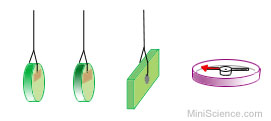|
Experiment 1 What are magnets and what do they do? You may try this experiment if you have samples of two or more different magnets. Standard and advanced electromagnet kits come with samples of different magnets. Materials:
|
||||
|
||||
| Procedure: Hang each of the magnets to a piece of string about 2 feet (60 centimeters) long. To do this you may need to tape the string to the magnet or you may pass the string through a hole in the magnet and make a knot. Connect the other ends of the strings to the edges of a table using masking tape. The magnets must be hanged freely, away from each other and away from any metal object or magnetic part. Magnets must be a few feet away from each other so they do not affect each other. Place the compass on the floor or on the table, away from other magnets and metal objects. Note the direction of north and the direction of south on the magnet. The north seeking end of a compass is marked with paint or shaped like an arrow. While the magnets are suspended by the string make a note of which end points to the North and which end points to the South.
|
||||
How to reverse the compass needle's direction? If you know which way is north from were you are but your compass is pointing the wrong way, there is a way to correct that problem. Take the compass and slowly bring the flat end of a super magnet towards the north end of the magnet needle. If the needle moves the other way, pull back the super magnet and then try again with the other flat end.
This method works for most compasses; however, if it did not work in the first time you may try again. When your compass is fixed check each magnet and see which side is north and which side is south. Then label each magnet by placing a small piece of masking tape and putting N for north and S for south. This way it will be easier for you to continue with this experiments and the others.
|


